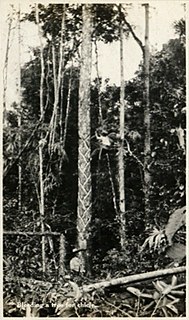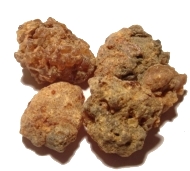 W
WGum is a sap or other resinous material associated with certain species of the plant kingdom. This material is often polysaccharide-based and is most frequently associated with woody plants, particularly under the bark or as a seed coating. The polysaccharide material is typically of high molecular weight and most often highly hydrophilic or hydrocolloidal.
 W
WGummosis is the formation of patches of a gummy substance on the surface of certain plants, particularly fruit trees. This occurs when sap oozes from wounds or cankers as a reaction to outside stimuli such as adverse weather conditions, infections, insect problems, or mechanical damage. It is understood as a plant physiological disease.
 W
WNatural gums are polysaccharides of natural origin, capable of causing a large increase in a solution's viscosity, even at small concentrations. They are mostly botanical gums, found in the woody elements of plants or in seed coatings.
 W
WAlginic acid, also called algin, is a polysaccharide distributed widely in the cell walls of brown algae that is hydrophilic and forms a viscous gum when hydrated. With metals such as sodium and calcium, its salts are known as alginates. It is a significant component of the biofilms produced by the bacterium Pseudomonas aeruginosa, a major pathogen found in the lungs of some people who have cystic fibrosis. The biofilm and P. aeruginosa have a high resistance to antibiotics, and are susceptible to inhibition by macrophages. Its colour ranges from white to yellowish-brown. It is sold in filamentous, granular, or powdered forms.
 W
Wβ-Glucans (beta-glucans) comprise a group of β-D-glucose polysaccharides naturally occurring in the cell walls of cereals, bacteria, and fungi, with significantly differing physicochemical properties dependent on source. Typically, β-glucans form a linear backbone with 1–3 β-glycosidic bonds but vary with respect to molecular mass, solubility, viscosity, branching structure, and gelation properties, causing diverse physiological effects in animals.
 W
WChicle is a natural gum traditionally used in making chewing gum and other products. It is collected from several species of Mesoamerican trees in the genus Manilkara, including M. zapota, M. chicle, M. staminodella, and M. bidentata.
 W
WDammar, also called dammar gum, or damar gum, is a resin obtained from the tree family Dipterocarpaceae in India and East Asia, principally those of the genera Shorea or Hopea. Most is produced by tapping trees, however, some is collected in fossilised form on the ground. The gum varies in colour from clear to pale yellow, while the fossilised form is grey-brown. Dammar gum is a triterpenoid resin, containing many triterpenes and their oxidation products. Many of them are low molecular weight compounds, but dammar also contains a polymeric fraction, composed of polycadinene. The name dammar is a Malay word meaning ‘resin’ or ‘torch made from resin’.
 W
WGalactomannans are polysaccharides consisting of a mannose backbone with galactose side groups (more specifically, a -linked beta-D-mannopyranose backbone with branchpoints from their 6-positions linked to alpha-D-galactose,.
 W
WGellan gum is a water-soluble anionic polysaccharide produced by the bacterium Sphingomonas elodea. The gellan-producing bacterium was discovered and isolated by the former Kelco Division of Merck & Company, Inc. in 1978 from the lily plant tissue from a natural pond in Pennsylvania, USA. It was initially identified as a substitute gelling agent at significantly lower use level to replace agar in solid culture media for the growth of various microorganisms. Its initial commercial product with the trademark as Gelrite gellan gum, was subsequently identified as a suitable agar substitute as gelling agent in various clinical bacteriological media.
 W
WGuar gum, also called guaran, is a galactomannan polysaccharide extracted from guar beans that has thickening and stabilizing properties useful in food, feed, and industrial applications. The guar seeds are mechanically dehusked, hydrated, milled and screened according to application. It is typically produced as a free-flowing, off-white powder.
 W
WGum arabic, also known as gum sudani, acacia gum, Arabic gum, gum acacia, acacia, Senegal gum, Indian gum, and by other names, is a natural gum consisting of the hardened sap of two species of the acacia tree, Acacia senegal and Vachellia (Acacia) seyal. The term "gum arabic" does not indicate a particular botanical source. In a few cases, the so-called "gum arabic" may not even have been collected from acacia species, but may originate from Combretum, Albizia, or some other genus. The gum is harvested commercially from wild trees, mostly in Sudan (80%) and throughout the Sahel, from Senegal to Somalia. The name "gum Arabic" was used in the Middle East at least as early as the 9th century. Gum arabic first found its way to Europe via Arabic ports, so retained its name. Gum arabic is a complex mixture of glycoproteins and polysaccharides predominantly consisting of arabinose and galactose. It is soluble in water, edible, and used primarily in the food industry and soft-drink industry as a stabilizer, with E number E414. Gum arabic is a key ingredient in traditional lithography and is used in printing, paint production, glue, cosmetics, and various industrial applications, including viscosity control in inks and in textile industries, though less expensive materials compete with it for many of these roles.
 W
WKino is a botanical gum produced by various trees and other plants, particularly bloodwood species of eucalypts and Pterocarpus, in reaction to mechanical damage, and which can be tapped by incisions made in the trunk or stalk. Many Eucalyptus, Angophora and Corymbia species are commonly referred to as 'bloodwoods', as the kino usually oozes out a very dark red colour. Kino flow in angiosperms contrasts with resin flow in conifers. The word kino is of Indian origin. In Australia, "red gum" is a term for kino from bloodwood trees and red acaroid resin from Xanthorrhoea spp.
 W
WKonjac is a common name of the East and Southeast Asian plant Amorphophallus konjac, which has an edible corm (bulbo-tuber). It is also known as konjaku, konnyaku potato, devil's tongue, voodoo lily, snake palm, or elephant yam.
 W
WMastic is a resin obtained from the mastic tree. It is also known as tears of Chios, being traditionally produced on the island Chios, and, like other natural resins, is produced in "tears" or droplets.
 W
WMyrrh is a natural gum or resin extracted from a number of small, thorny tree species of the genus Commiphora. Myrrh resin has been used throughout history as a perfume, incense and medicine. Myrrh mixed with posca or wine was common across ancient cultures, for general pleasure and as an analgesic.
 W
WPsyllium, or ispaghula (isabgol), is the common name used for several members of the plant genus Plantago whose seeds are used commercially for the production of mucilage. Psyllium is mainly used as a dietary fiber to relieve symptoms of both constipation and mild diarrhea, and occasionally as a food thickener. It is commonly used as a food ingredient in manufactured breakfast cereals which may contribute to a healthy lifestyle by improving blood cholesterol levels and gastrointestinal function.
 W
WA self-adhesive stamp is a postage stamp with a pressure-sensitive adhesive that does not require moistening in order to adhere to paper. They are usually issued on a removable backing paper.
 W
WTragacanth is a natural gum obtained from the dried sap of several species of Middle Eastern legumes of the genus Astragalus, including A. adscendens, A. gummifer, A. brachycalyx, and A. tragacantha. Some of these species are known collectively under the common names "goat's thorn" and "locoweed". The gum is sometimes called Shiraz gum, shiraz, gum elect or gum dragon. The name derives from the Greek words tragos and akantha ("thorn"). Iran is the biggest producer of this gum.
 W
WXanthan gum is a polysaccharide with many industrial uses, including as a common food additive. It is an effective thickening agent and stabilizer to prevent ingredients from separating. It can be produced from simple sugars using a fermentation process, and derives its name from the species of bacteria used, Xanthomonas campestris.